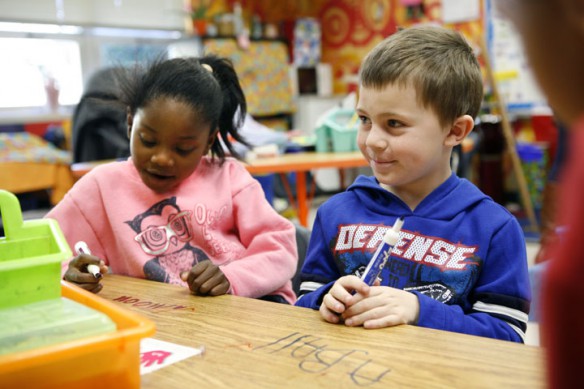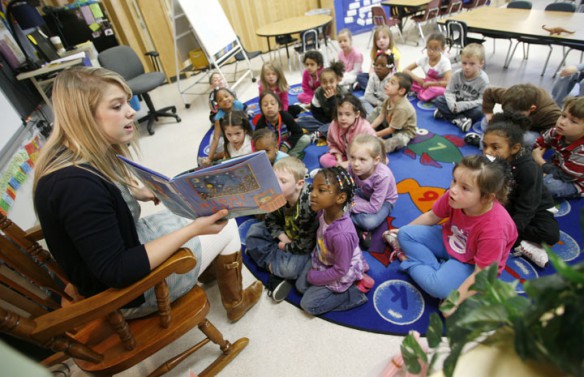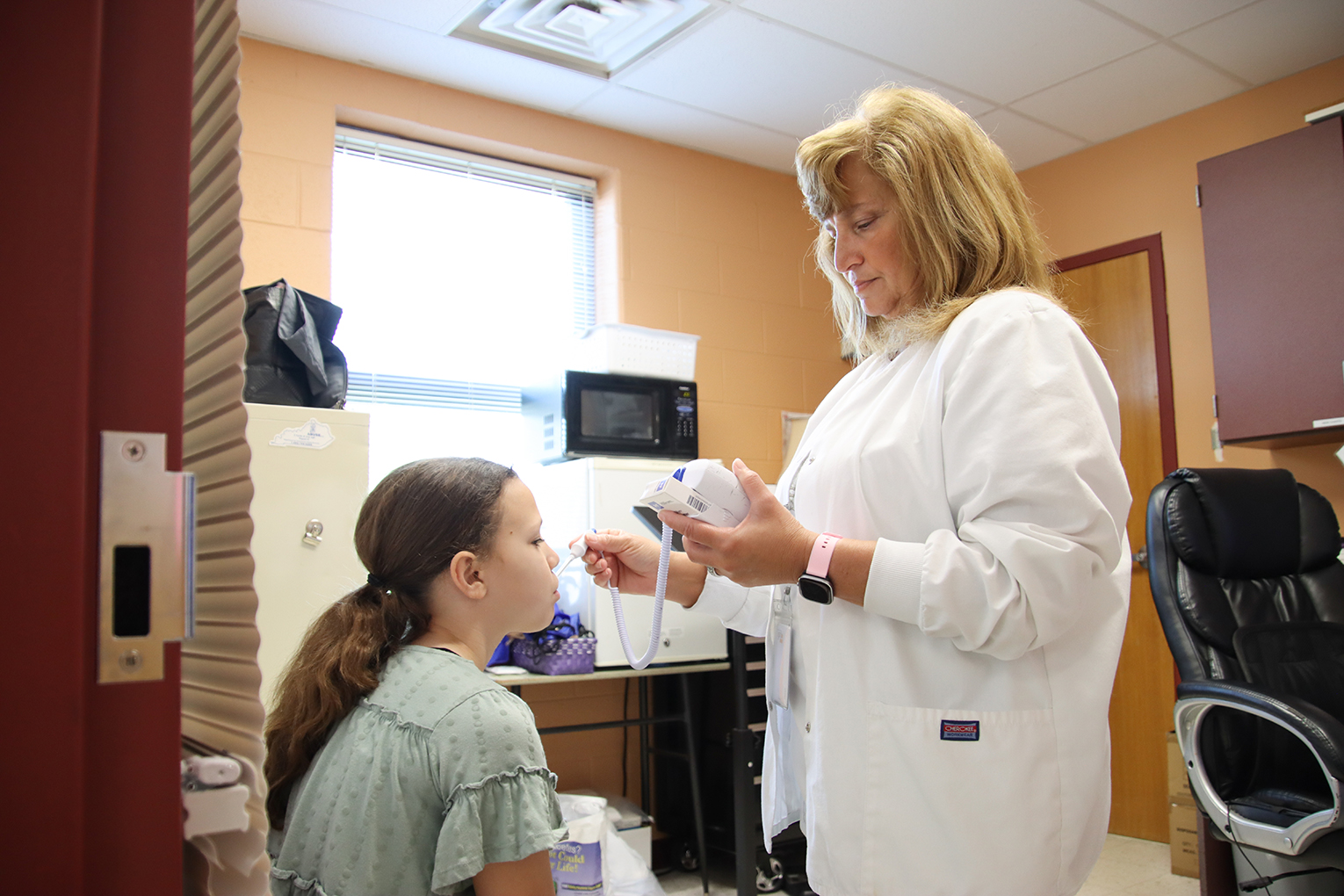
Kindergarten students Terriona McDaniel and Brenden Parson write an example of a sphere during Tara Macke’s class at Glenn O. Swing Elementary School (Covington Ind.). The students were learning about 3-D shapes. Photo by Amy Wallot, April 12, 2012
By Matthew Tungate
Scott Alter, principal of Glenn O. Swing Elementary (Covington Independent), can see a big difference between incoming kindergartners who are ready for school and those who aren’t.
“If they come in ready for kindergarten, they just take off,” said Alter, in his third year as principal and 16th overall in education.
For those who aren’t ready, good screeners can find deficiencies and good teachers can catch them up to their peers, he said.
“But you’re catching them up,” Alter emphasized. “You’re not excelling them like you could if they were ready.”
How many students statewide enter kindergarten prepared is unknown, according to Bill Buchanan, School Readiness branch manager for the Kentucky Department of Education. That is one reason the Kentucky Board of Education has approved a statewide kindergarten entry screener to be implemented voluntarily this fall. The Kentucky Department of Education has contracted with Curriculum Associates and will be using the BRIGANCE Kindergarten Screen as the common kindergarten readiness screener.
The screener will provide education officials, lawmakers and the public with reliable, comparable data from across the state about how ready children are to start school, Buchanan said.
“The data will help us understand how many children are ready to learn,” he said. “It’s an important piece of the puzzle.”
The screener, which will be aligned with Kentucky’s school readiness definition and the Kentucky Early Childhood Standards, will provide districts with a way to measure students’ readiness for school in five areas: adaptive, cognitive, motor, communication and social-emotional.
As a result of efforts by the Governor’s Task Force on Early Childhood Development and the Early Childhood Advisory Council, Kentucky has a holistic, developmentally appropriate approach to school readiness, Buchanan said.
“We’re emphasizing more than just cognitive development,” he said. “Our definition also emphasizes the importance of social/emotional development, health and physical well-being. It’s much more than whether a child knows a certain number of letters and numbers. It’s the idea that all areas of development are connected together, as well as the idea that children learn at different rates and have different learning needs.”
Debbie DeLong, principal at Louisa West Elementary School (Lawrence County), has a grandchild in kindergarten at her school. Recently, her granddaughter split a piece of candy into three pieces and knew each was one-third. Even more recently, kindergartners were learning about antonyms and synonyms, and they can identify nouns, verbs and adjectives.
While the only standard for entering kindergarten is to be 5 years old by Oct.1, DeLong said students are expected to know a lot by the time they head to 1st grade.
“If you look at the new (Kentucky Core Academic Standards) for kindergarten, you would be amazed,” she said. “The new core content will just knock your socks off.”
The school’s kindergarten screener helps her put children of various abilities into all of her kindergarten classes, DeLong said.
Principal Ann Taylor and guidance counselor Carla Major began screening incoming kindergartners at Trigg County Primary School when Major arrived at the school in 2007.
The screener, which yields a measure of cognitive, language and motor skills, gives “our teachers and our parents an idea of where those students are,” Major said.
“In kindergarten they come in at all levels,” she said. “Some of them are already reading, and some of them don’t recognize their names yet.”
Taylor said Major meets with each parent and discusses the child’s strengths and weaknesses on the screener and gives them activities to help improve the child’s school readiness.
“This allows us as a school system to know where these students are and how to adapt our program so that when they come in on the first day, we’re ready to provide them with the best interventions possible,” Taylor said.

Ellen Cochran reads Night City by Monica Wellington to her kindergarten class at Glenn O. Swing Elementary School (Covington Ind.). Photo by Amy Wallot, April 12, 2012
Having a screener also helps Alter’s district work with early childhood providers to better prepare students for kindergarten, he said.
“The more prepared our kids come in to kindergarten, the better chance we have of getting them where we need to,” he said. “It all starts as young as possible.”
Buchanan said schools and districts will have to work closely with their early childhood partners, such as Head Start and child care centers, if they are going to increase the number of incoming kindergartners prepared for school.
“It’s going to elevate the conversation of readiness within communities,” he said.
Taylor said her school already works closely with preschool providers thanks to a strong community early childhood council. The school has a grant from the council that allows it to provide training for preschools and daycares. She said it is a win-win for both parties.
“They’re eager for the information and the assistance and the training, and we are eager to assist because we know it’s going to help our students when they come to school,” Taylor said.
Because the school has used the same screener since 2007, it is able to track whether more students are ready for school each year, she said.
“So we know what area we need to increase training in or what areas we need to inform our daycares more about,” she said. “It is an entire community that has to be on board with you.”
For DeLong, her connections to the district’s preschool and Head Start programs are very tight – those 150 students are in her building. So her kindergarten teachers know most of their incoming students well before the first day, she said.
It reminds her of how much more attention early childhood education gets than when her now-grown children were attending a private nursery school with 24 children.
“Now I look at how many children are coming to preschool and how many are coming to Head Start,” DeLong said. “I think we’ve caught on in the last 20-some years as to how important early childhood education is.”
Buchanan said it’s time for people to start recognizing the long-lasting implications of early childhood education. For instance, research shows that for every $1 spent on high-quality preschool, the state gets as much as $17 in return.
“The foundation for college and career readiness isn’t set in middle or high school,” he said. “It’s actually set in the earliest years.”
Taylor said Kentucky has been on the right track about moving preschool and early childhood education to the forefront.
“Research shows you that the more money we invest up front when children are young, and the more that we can provide them educationally, the better we’re all going to be,” she said. “It’s going to affect our high school graduation rates, all the way K-12, college and career, and 21st century – all that’s going to be affected by that student who’s 3, 4 and 5 (years old) coming in with a much better education.”




Leave A Comment